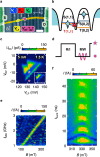Compromise-free scaling of qubit speed and coherence
- PMID: 40817078
- PMCID: PMC12356937
- DOI: 10.1038/s41467-025-62614-z
Compromise-free scaling of qubit speed and coherence
Abstract
Across leading qubit platforms, a common trade-off persists: increasing coherence comes at the cost of operational speed, reflecting the notion that protecting a qubit from its noisy surroundings also limits control over it. This speed-coherence dilemma limits qubit performance across various technologies. Here, we demonstrate a hole spin qubit in a Ge/Si core/shell nanowire that triples its Rabi frequency while simultaneously quadrupling its Hahn-echo coherence time, boosting the Q-factor by over an order of magnitude. This is enabled by the direct Rashba spin-orbit interaction, emerging from heavy-hole-light-hole mixing through strong confinement in two dimensions. Tuning a gate voltage causes this interaction to peak, providing maximum drive speed and a point where the qubit is optimally protected from charge noise, allowing speed and coherence to scale together. Our proof-of-concept shows that careful dot design can overcome a long-standing limitation, offering a new approach towards building high-performance, fault-tolerant qubits.
© 2025. The Author(s).
Conflict of interest statement
Competing interests: The authors declare no competing interests.
Figures



References
-
- Loss, D. & DiVincenzo, D. P. Quantum computation with quantum dots. Phys. Rev. A57, 120–126 (1998).
-
- Stano, P. & Loss, D. Review of performance metrics of spin qubits in gated semiconducting nanostructures. Nat. Rev. Phys.4, 672–688 (2022).
-
- Burkard, G., Ladd, T. D., Pan, A., Nichol, J. M. & Petta, J. R. Semiconductor spin qubits. Rev. Mod. Phys.95, 025003 (2023).
-
- Laucht, A. et al. A dressed spin qubit in silicon. Nat. Nanotechnol.12, 61–66 (2016). - PubMed
-
- Yoneda, J. et al. A quantum-dot spin qubit with coherence limited by charge noise and fidelity higher than 99.9%. Nat. Nanotechnol.13, 102–106 (2017). - PubMed
LinkOut - more resources
Full Text Sources

